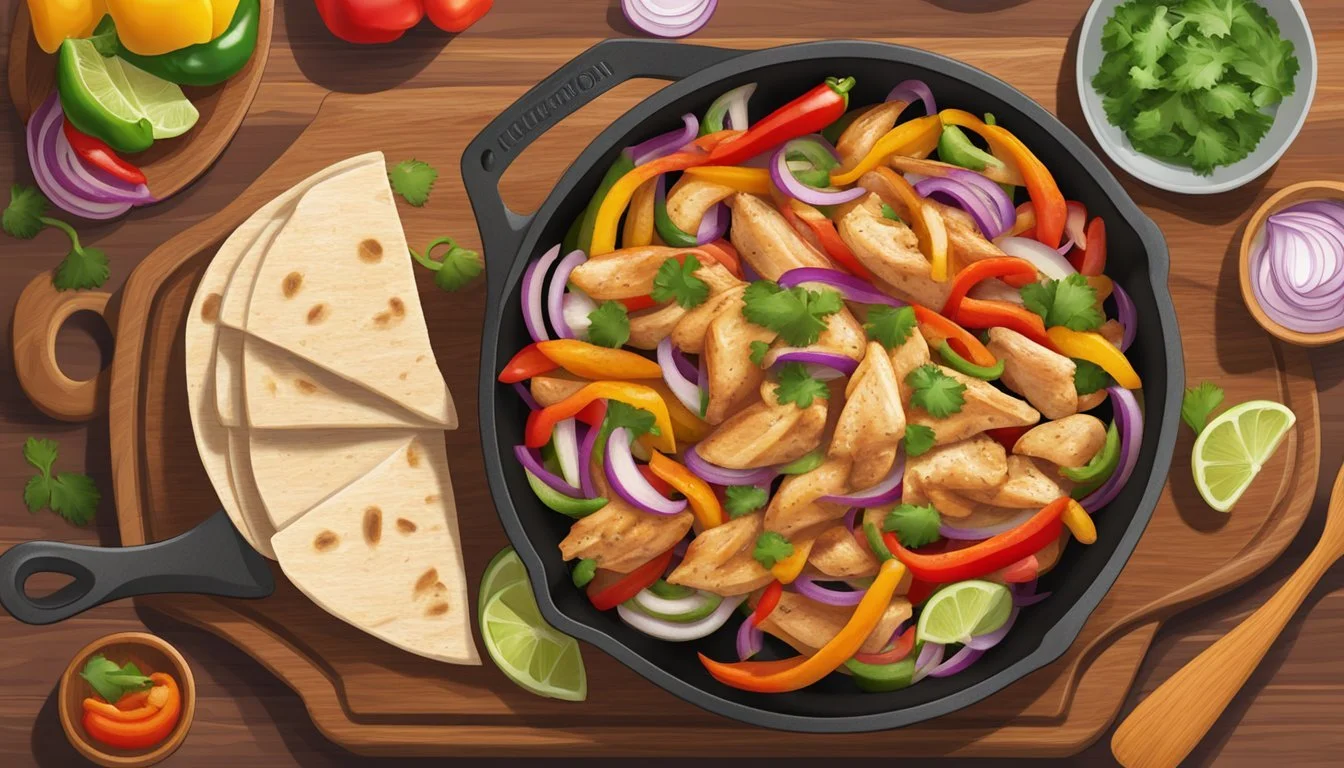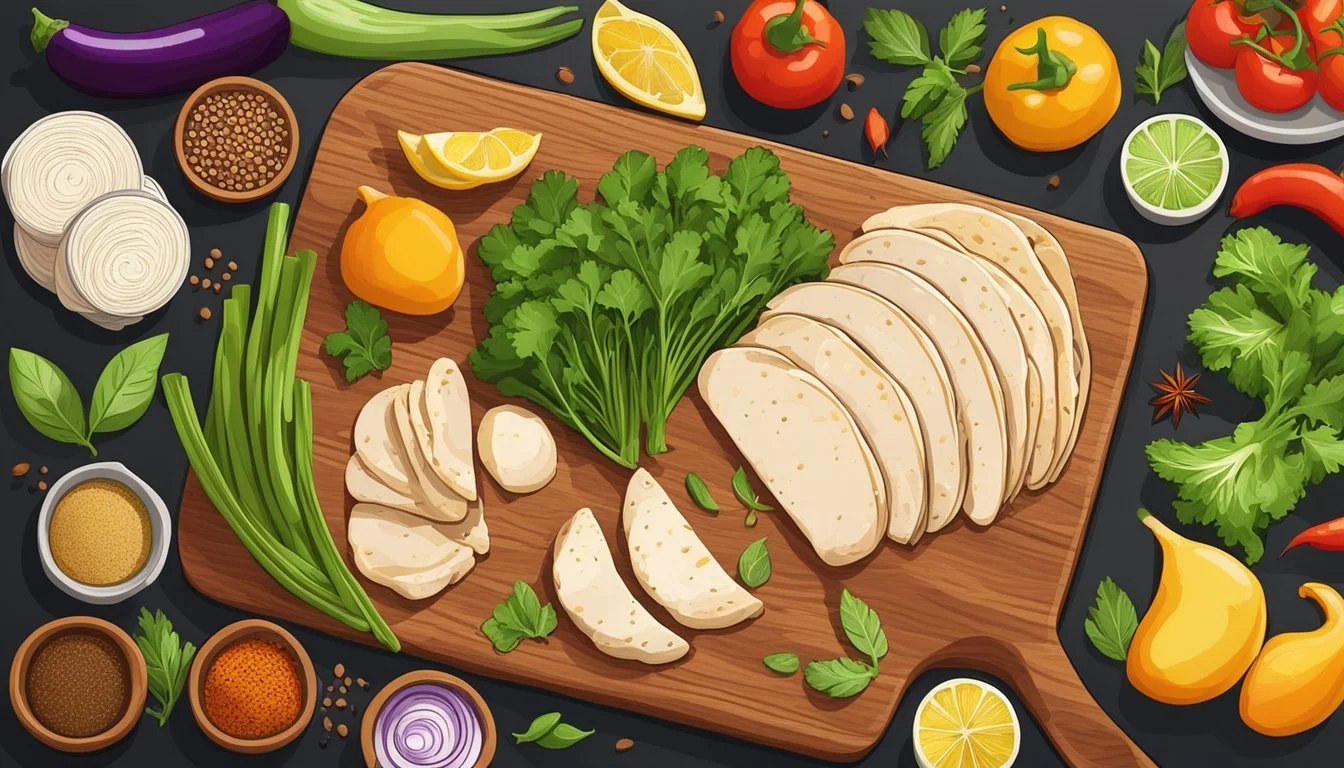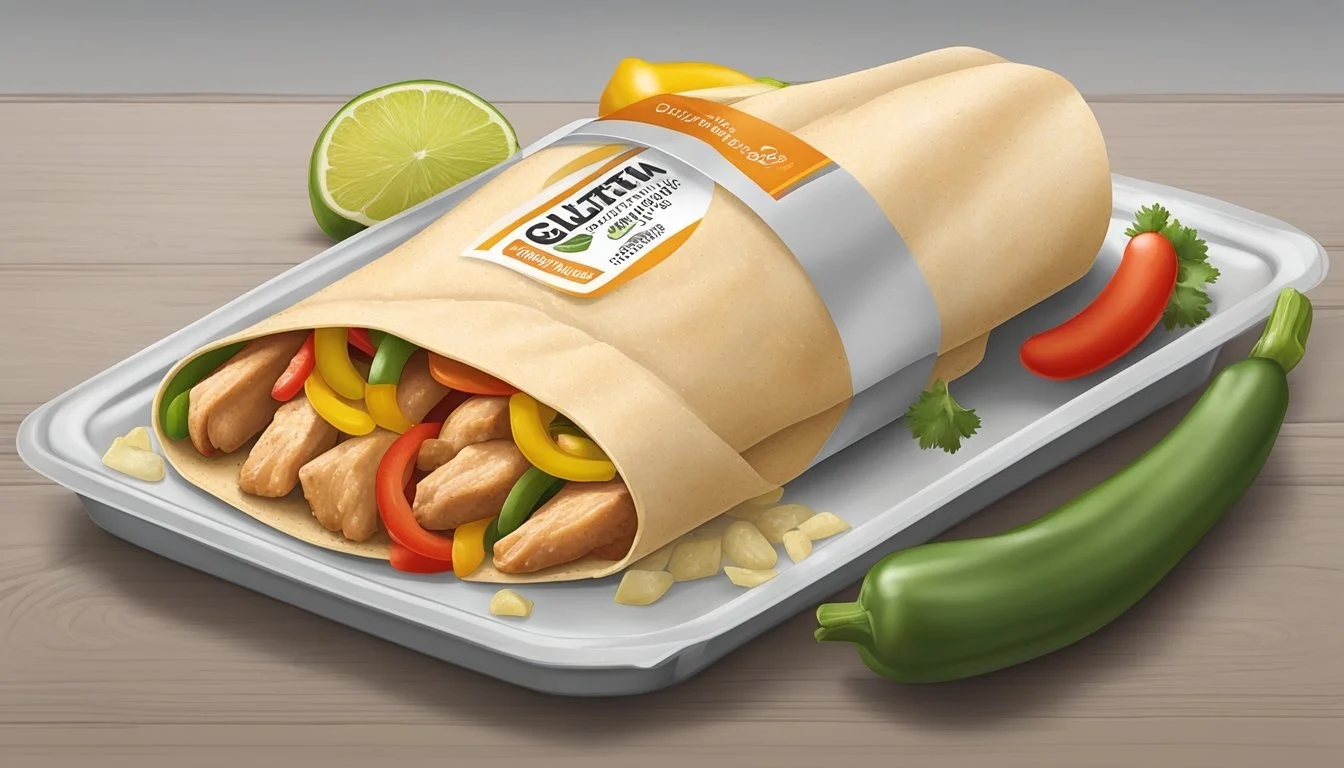How Long Do Gluten-Free Chicken Fajitas Last?
Storage Tips and Shelf Life
Gluten-Free Chicken Fajitas are a delicious and healthy meal option that caters to those looking to avoid gluten without sacrificing flavor. These fajitas combine perfectly seasoned chicken and vibrant vegetables, creating a dish that's both satisfying and nutritious. Proper storage is crucial to ensuring they remain safe and tasty for future consumption.
When stored in an airtight container in the refrigerator, gluten-free chicken fajitas generally last for up to 3-4 days. It's important to cool the fajitas to room temperature before refrigerating to maintain their texture and prevent excess moisture buildup. For longer storage, freezing the fajitas can extend their shelf life to about 2 months.
Reheating gluten-free chicken fajitas is straightforward. Heating them in a skillet can help retain their original flavor and texture. Whether enjoying leftover fajitas as a quick meal or repurposing them into new dishes, proper storage ensures they remain both safe and delicious.
Understanding Gluten-Free Chicken Fajitas
Gluten-free chicken fajitas are a popular choice for those avoiding gluten. These fajitas maintain the delicious flavors of traditional fajitas while ensuring safe consumption for individuals with gluten sensitivities or celiac disease.
Key Characteristics of Gluten-Free Fajitas
Gluten-free chicken fajitas primarily feature chicken, vegetables, and gluten-free spices. The chicken is generally sliced into strips and seasoned with a mix of garlic powder, onion powder, paprika, chili powder, salt, and pepper.
Vegetables:
Peppers and onions are commonly used. They add flavor and nutritional value while keeping the dish colorful and vibrant.
Cooking Methods:
Methods like baking on a sheet pan or cooking in a skillet with avocado oil are popular. These methods ensure the chicken is cooked through, reaching an internal temperature of 165°F.
Gluten-Free Tortillas:
The tortillas must be explicitly labeled gluten-free. Options include grain-free tortillas or those made from alternative flours like rice or almond. This ensures the meal remains safe for those with gluten concerns.
Difference Between Gluten-Free and Regular Fajitas
The main difference lies in the use of gluten-free ingredients. Regular fajitas often use wheat-based tortillas, while gluten-free versions use alternatives like corn tortillas, rice tortillas, or specifically labeled gluten-free tortillas.
Gluten-Free Spices:
Regular fajitas might include pre-made spice mixes that contain gluten. In contrast, gluten-free fajitas use fresh or single-ingredient spices without additives.
Preparation:
Cross-contamination is a critical concern. Gluten-free fajitas require careful preparation to avoid contact with gluten-containing foods. This might involve using separate cooking utensils and surfaces to maintain the dish’s integrity.
These distinctions ensure those with gluten sensitivities can enjoy the flavors of traditional fajitas without adverse health effects.
Ingredients and Substitutes
To make gluten-free chicken fajitas flavorful and flexible, choose quality proteins, suitable tortillas, and various vegetables and spices. This section will provide detailed guidance on selecting and substituting ingredients effectively.
Choosing the Right Proteins
Chicken is the most popular choice for fajitas. Opt for boneless, skinless chicken breasts or thighs. Thighs tend to be juicier and have more flavor, while breasts are leaner. For a vegetarian option, consider tofu or tempeh, seasoned similarly to chicken to absorb the same flavors.
Gluten-Free Tortillas and Alternatives
Traditional fajitas use flour tortillas, which contain gluten. Corn tortillas are naturally gluten-free and a common alternative. For a different texture, try cassava flour tortillas or lettuce wraps. Lettuce wraps provide a low-carb option while maintaining crispness and freshness.
Vegetables and Spices for Flavor
Peppers, onions, and garlic form the base of fajita vegetables. Use a mix of green, red, and yellow peppers to add color and different flavors. Onions should be sliced thin and cooked until caramelized. Garlic adds depth and can be minced or sliced.
For spices, classic fajita seasoning includes paprika, cumin, chili powder, garlic powder, onion powder, salt, and black pepper. Fresh cilantro can also be added for a burst of freshness. Avocado or guacamole makes an excellent topping, providing creaminess and healthy fats.
Homemade vs. Store-Bought Ingredients
Making components from scratch, such as seasoning mixes or tortillas, allows for control over ingredients and quality. Homemade tortillas can be made from masa harina for a fresher taste. Pre-made seasoning mixes are convenient but check labels for added gluten.
Store-bought items should ideally be certified gluten-free. Cheese, if used, should be full-fat and shredded at home to avoid anti-caking agents that may contain gluten.
Preparation Techniques
To create delicious gluten-free chicken fajitas, it's essential to focus on marinating the chicken properly, using effective cooking methods, and assembling the ingredients efficiently. This ensures vibrant flavors and a satisfying meal.
Marinating and Seasoning
Start with a large ziploc bag to combine gluten-free fajita seasoning, including cumin, chili powder, salt, and paprika. Add the chicken slices, ensuring they are thoroughly coated. Marinate in the fridge for 30 minutes to 1 hour. Enhance flavors by adding lime juice and a bit of avocado oil. This blend of spices and marinade enhances the flavor and tenderizes the chicken.
Cooking Methods
There are several methods to cook the marinated chicken and vegetables. Use a preheated oven at 375°F-425°F, placing the seasoned mixture on a lined sheet pan. Bake for 20-23 minutes until the chicken reaches an internal temperature of 165°F.
Alternatively, a skillet heated on medium-high with a bit of oil can cook the chicken to a golden brown. Uniformly slice bell peppers and onions, and add them to the pan. For a smoky flavor, grill the chicken and veggies on a hot grill, turning occasionally for even cooking.
Assembling the Fajitas
Once the chicken and vegetables are cooked, spread them evenly on a plate or serving dish. Provide gluten-free tortillas, allowing each person to assemble their fajitas. Add toppings like sour cream, guacamole, or chopped cilantro according to preference. Serve with lime wedges for an extra citrusy kick.
Storage Recommendations
Gluten-free chicken fajitas can last for several days when stored properly. This section provides detailed guidance on storing them in the refrigerator and freezer, ensuring they remain fresh and safe to eat.
Proper Storing Techniques
To keep chicken fajitas fresh, first allow them to cool to room temperature. Store in airtight containers or resealable plastic bags to prevent contamination and moisture loss.
Airtight containers: Ensure lids are sealed securely.
Plastic bags: Squeeze out as much air as possible before sealing.
Labeling: Clearly label with the date of preparation.
Store separate components, such as fajita filling and tortillas, for optimal freshness.
Shelf Life in the Refrigerator
When stored correctly in the refrigerator, gluten-free chicken fajitas should last 3-4 days. Maintain a refrigerator temperature of 40°F (4°C) to slow bacterial growth.
Check regularly for signs of spoilage:
Smell: Off or sour odor indicates spoilage.
Look: Discoloration or unusual textures.
Taste: Unpleasant flavors mean it’s time to discard.
Consume within this timeframe to enjoy the best taste and texture.
Freezing for Long-Term Storage
For extended storage, freeze chicken fajitas. Properly stored, they can last up to 3 months in the freezer.
Preparation: Cool completely before freezing.
Packaging: Use heavy-duty freezer bags or airtight containers to prevent freezer burn.
Labeling: Mark with the freezing date.
To thaw, transfer from freezer to refrigerator and allow 24 hours to thaw fully. Reheat thoroughly before consuming.
Using these methods ensures that gluten-free chicken fajitas remain delicious and safe over time. Regular checks for spoilage and proper temperature maintenance are essential.
Serving Suggestions
Pairing gluten-free chicken fajitas with complementary sides and toppings enhances their flavor and presentation, ensuring an enjoyable dining experience.
Accompaniments and Toppings
Consider serving gluten-free chicken fajitas with salsa, guacamole, and sour cream for added zest. Fresh salsa provides a burst of flavor from tomatoes, onions, and cilantro, while guacamole adds a creamy texture from ripe avocados. Sour cream can balance the spiciness of the chicken. Additionally, slices of lime can be offered to add a citrusy brightness.
For those preferring a healthier option, use avocado oil when preparing vegetables. This oil enhances the vegetables' flavors while offering health benefits. Including a bowl of shredded lettuce, diced tomatoes, and cheese as optional toppings allows customization to each diner’s preference.
Serving Sizes and Presentation
To serve gluten-free chicken fajitas attractively, present the chicken and vegetables separately on a large platter. This display allows everyone to build their own fajitas. Traditionally, each person might get about 4 ounces of chicken and a generous portion of vegetables.
Providing gluten-free tortillas ensures that dietary needs are met. Warm the tortillas just before serving to keep them pliable. Offering small bowls of the aforementioned accompaniments and toppings alongside can make the meal interactive and visually appealing. Using garnishes like fresh cilantro enhances the dish’s presentation.
Nutritional Information
Gluten-free chicken fajitas are a nutritious and savory option packed with essential nutrients and relatively low in calories. They provide a good balance of macronutrients and cater to various dietary needs and sensitivities.
Macronutrient Breakdown
One serving of gluten-free chicken fajitas typically contains around 250-300 calories. The primary source of protein comes from the chicken, offering around 20-25 grams of protein per serving.
Fats range between 10-15 grams, depending on the oil used during cooking. Carbohydrates come from the vegetables and tortillas, amounting to 20-25 grams per serving. Fiber content is usually 3-5 grams, aiding in digestion, while sugar remains minimal, around 2-4 grams.
Sodium levels can vary, often falling between 500-700 milligrams, influenced by seasoning. Cholesterol content is close to 70-80 milligrams, attributed primarily to the chicken.
Understanding Allergens and Sensitivities
Individuals with gluten sensitivities can safely enjoy these fajitas as they are made using gluten-free tortillas and seasonings. It’s crucial to check for cross-contamination during preparation to maintain their gluten-free status.
Dairy-free variations are also possible by omitting or replacing any cheese or dairy-based toppings. The recipe can be soy-free if soy sauce or other soy products are not used.
Nutritional elements like iron, potassium, and calcium play significant roles. Bell peppers, for instance, contribute vitamin C and vitamin A, enhancing the meal’s nutrient profile. Always ensure that spices and additives do not introduce unwanted allergens.
Health Benefits
Gluten-free chicken fajitas offer numerous health benefits by incorporating a balanced mix of protein, vegetables, and healthy dietary choices. Key advantages include support for those with gluten intolerance and the promotion of a wholesome diet plan.
Gluten-Free Diet Advantages
For individuals with celiac disease or gluten intolerance, consuming gluten-free chicken fajitas eliminates the risk of adverse reactions. Gluten is a protein found in wheat, barley, and rye, which can cause severe digestive issues for those with sensitivities.
By choosing gluten-free options, they ensure their diet remains safe and manageable. Additionally, a gluten-free diet can promote digestive health and reduce inflammation, contributing to overall well-being.
Balanced Meal Planning
Chicken fajitas provide a well-rounded meal by combining lean protein and nutrient-rich vegetables. Chicken, a healthy source of protein, supports muscle repair and growth. Vegetables such as bell peppers and onions are high in vitamins, minerals, and fiber, assisting in digestive health and supporting immune function.
This combination maintains energy levels and promotes a balanced diet. The use of spices and herbs not only adds flavor but also offers health benefits, including antioxidant properties. This makes gluten-free chicken fajitas an excellent choice for a nutritious, satisfying meal.
Cooking Tips and Tricks
Master the art of making gluten-free chicken fajitas with these cooking tips and tricks. These insights will help you enhance flavor and efficiently cook in batches for easier meal planning.
Enhancing Flavor
Start by using fresh ingredients. Fresh bell peppers, onions, and garlic can significantly elevate the taste of your fajitas.
Marinate the chicken for at least 30 minutes to absorb the spice mixture fully. For extra zest, drizzle lime juice over the chicken before cooking.
Consider high-quality spices like cumin, paprika, and chili powder.
Layer flavors by adding a pinch of sea salt and black pepper.
Increase moisture in the chicken by using a small amount of oil, such as olive or avocado oil.
Cook at high heat (e.g., 425°F) to quickly sear the chicken and vegetables, locking in the juices and charring the edges.
Cooking in Batches
Cooking gluten-free chicken fajitas in batches saves time and extends meal usability.
Prepare a large quantity of chicken and vegetables, and arrange them on a one pan sheet for even cooking.
Store the cooked fajita mix in airtight containers.
Refrigerate and consume within 3-4 days, or freeze for up to 2 months.
Reheat by placing portions in a skillet over medium heat, or use the microwave for quicker results.
Batch cooking makes it easier to prepare multiple meals, reducing the total cook time each week.
Prep time is also minimized since you only chop and season once, making the recipe easy to make repeatedly.
Focusing on batch cooking ensures you always have a ready-to-enjoy, flavorful meal at hand.









